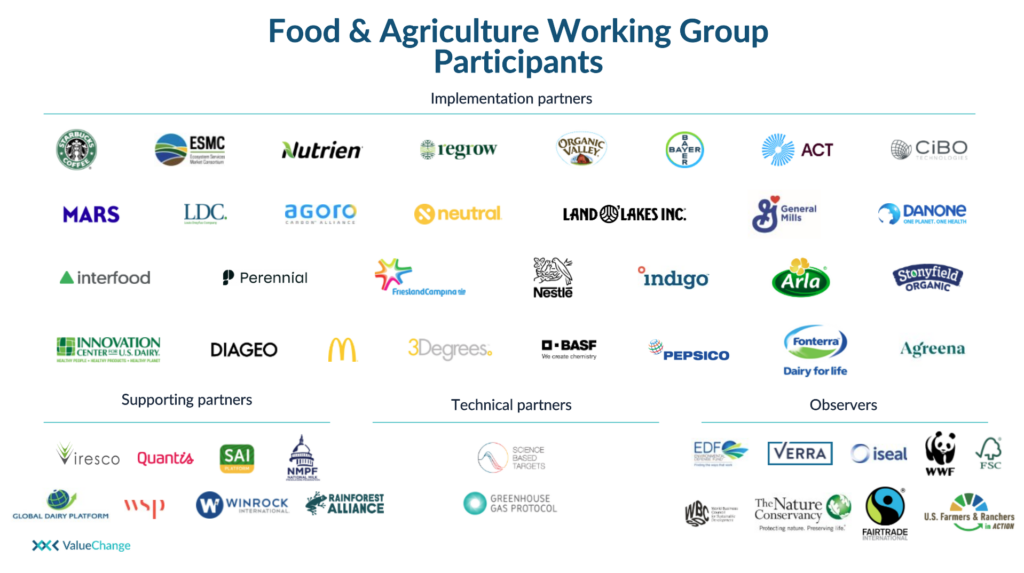Net Zero food and agriculture value chain in the making
Dino De Francesco
The Food and Agriculture sector is directly responsible for close to one quarter of the total global CO2eq emissions. The sector faces increasing pressure to decarbonise, while also needing to transform to feed nearly 10 billion people.
Despite increasing action in many areas, the intrinsic complexity of the sector requires further cooperation to catalyse and scale effective solutions. The fourth iteration of the VCI Food & Agriculture Working Group launched in November 2023, with the aim of removing barriers to account, report and claim Scope 3 decarbonisation interventions, and with this accelerate the transition to a Net Zero sector.
The Working Group is joined by 30 industry leading companies, including Starbucks, Danone and General Mills, as well as key non-profit organisations among the technical partners and observers, such as GHG Protocol and Science Based Targets initiative.
What are the key areas of work identified by the Working Group members through a co-creation process, and how will they address these questions in the upcoming sessions?

How to allocate impacts in complex agricultural value chains?
Allocating impacts from decarbonisation interventions to the investing companies is often not straightforward. Farms produce multiple crops in a rotation, and parent products frequently create multiple by-products of which off-takers only source one. Think of corn being grown and impacted by a decarbonisation intervention, while the investor and off-taker only sources the cornmeal. How can companies allocate mitigation outcomes in situations of crop rotation and by-products?
Currently available approaches to allocation can lead to stranded assets, as the investing company is not able to make use of the full generated mitigation impacts if they fall on the non-target crops or the non-target by-products.
The Working Group has identified two potential solutions for each case, which are now being explored and developed further. The Working Group is developing an overview that helps to understand which solution is best under what conditions, and what safeguards are needed to maintain credibility and accuracy.
How to further operationalise the Supply Shed concept?
In previous guidance, the VCI has developed the Supply Shed accounting concept to address issues of limited traceability in complex value chains. It can be used in situations where a company may not be able to directly trace sourcing to a specific upstream supplier, but it is known (and can be demonstrated) that sourcing comes from a group of suppliers within a “market” providing functionally equivalent goods or services (commodities) from which the company sources, preferably at sub-national level.
Many companies are already utilising the Supply Shed concept, but different approaches still exist on how to design and use a Supply Shed, leading to inefficiencies and uncertainty for the companies involved. In the two recent sessions, members of the Working Group presented how their companies design and utilise Supply Sheds. This will be used as a basis to co-create guidance to further operationalise the Supply Shed concept, ideally at sub-sector level.
How to use intervention and inventory accounting in Scope 3?
There is confusion among companies about when to use certain accounting approaches, and whether companies are expanding beyond the boundaries of what is described in existing guidance when applying them.
Can intervention accounting be used in inventories, and can inventory accounting be used to incorporate intervention results? The VCI has begun addressing these questions in its Value Chain Interventions Guidance and has developed a substitution approach to link the two accounting approaches. The current Working Group will continue this work by further increasing clarity on their applicability within the Scope 3 domain. This topic will be further explored in the fourth session of the Working Group.
Intervention accounting (also known as project accounting methods) is an assessment of the GHG emissions of actions relative to counterfactual baseline scenarios (conditions most likely to occur in the absence of the action) or other performance standards. [From GHG Protocol Land Sector Removals Guidance draft]
Inventory accounting is used to calculate and report annual GHG emissions from sources (and removals by sinks, if applicable) within the reporting entity’s inventory boundary. GHG inventories reflect direct (Scope 1) and indirect emissions (Scope 2 and 3), where progress is tracked relative to a historic base year or period. [From VCI Food and agriculture addendum: Achieving net zero through value chain mitigation interventions]
Insights from our technical partners Science Based Targets initiative and Greenhouse Gas Protocol
As part of the Working Group, we are honoured to welcome guest speakers from our technical partners Science Based Targets initiative (SBTi) and Greenhouse Gas Protocol (GHG Protocol) to provide insights on recent and upcoming changes in the reporting landscape.
In the most recent session, we were joined by Tereza Bicalho, Agriculture, Forestry and Other Land Use (AFOLU) Lead from the SBTi. She presented recent updates in the Forest, Land and Agriculture Guidance (FLAG) 1.1, and answered several key questions from the members.
In the next session, we are happy to welcome guest speaker Matt Ramlow, Research Associate at Greenhouse Gas Protocol. He will be speaking about updates to the Land Sector and Removals Guidance (LSRG), currently in its draft phase and expected to be published later in 2024.
Interested to join leading companies in mapping Scope 3 action in Food & Agriculture?
It is still possible to join the Working Group.

